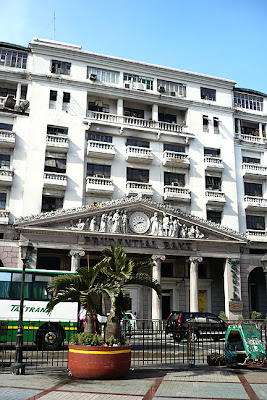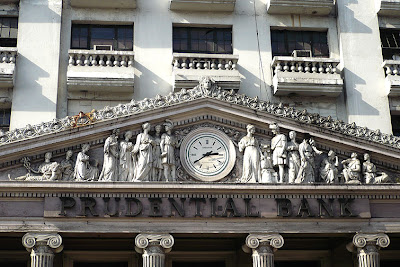Monday, January 28, 2008
TIKIM: MANILA'S OLDEST RESTAURANTS
1) Tie: AMBOS MUNDOS / TOHO FOOD CENTER aka TOHO ANTIGUA (since 1888)
2) NEW SAN JACINTO FOOD CENTER CORP. aka PANCITERIA SAN JACINTO (since 1894)
3) MA MON LUK (since 1920)
4) RAMON LEE FRIED CHICKEN (since 1929)
5) ARISTOCRAT (since 1936)
6) ONGPIN MANOSA (since 1940)
7) Tie: RODIC'S & LITTLE QUIAPO (since 1949)
8) SAVORY (since 1950)
9) WAH SUN (since 1955)
Source: Frugalchowhound Yahoo Group
Sunday, January 20, 2008
PIYESTA NG TONDO (TONDO FIESTA)
The most famous among these festivals is, of course, Cebu's Sinulog. Although a recent concoction of Cebu's local leaders (just around 25 years old or thereabouts) to attract tourists to the beautiful island-city, the Sinulog has become the new face of these festivities surrounding the Niño. Of course it would be too unfair not to mention the Dinagyang of Iloilo and the Ati-Atihan of Aklan, both of which symbolize much of what religious fiesta means to the Philippines (the feast of the Black Nazarene is another story).
However, one festival remains obscure and this is the fiesta of the Niño in Tondo, in the city of Manila. I've lived in Cebu for 5 years and I have honestly grown tired of the Sinulog's one-step-forward-two-steps-backward routine, and the blatant commercialization of what is supposed to be a religious festival (I won't be surprised if the Niño will soon find itself clutching a beer bottle instead of a globe). This January, being my first time to visit Tondo, I made sure I was accompanied by a resident in the person of CBCP's Stephen Borja in visiting the "other" Niño of Tondo.

The image of the Sto Niño de Tondo. You can reach this via a staircase on the side of the church. 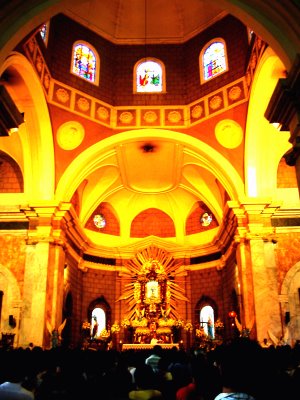
Altar and cupola glow during the High Mass
Detail. The belfry.
Facade sports left-over decors from Christmas. It is rare to find public clocks that work, but it is doubly rare to find one on a facade of a Philippine church building!
Ubiquitous vendors sprawl across the church's front lawn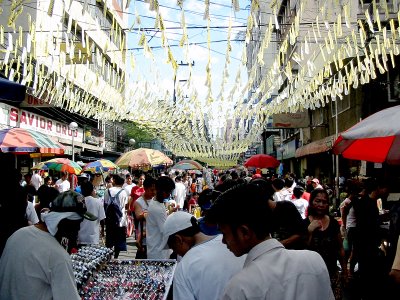
Busy side streets surrounding the church
Broken images of several saints and of the Niño take solace in a lonely space near the altar. It is a custom in the Philippines to never throw away broken images of saints as these were blessed by a priest and thus are considered holy.
Pinipig for sale! Fragrant and chewy, they are a tourist's best friend during long walks like this. We used to buy this in San Fernando, Pampanga and Baguio, too.
Light a wish. Each color represents something. Pink for health, for instance. White for purity (of heart, I presume). Green for money. Brown for family requests. Blue is for inner peace. You can pray for all of the above by lighting a mega candle, where all the colors are twisted in one.
Friday, January 18, 2008
THE ANTIPOLO CATHEDRAL (PART UN)
AT KAYONG LAHAT AY SA AMIN SUMAMA
BAKIT? SAAN BA TAYO PUPUNTA ?
SA ANTIPOLO NA LAGING MASAYA!
CHORUS :
TAYO NA SA ANTIPOLO
AT DOON MALIGO TAYO
SA BATIS NA KUNG TAWAGIN
AY HI.. HI.. HINULUGANG TAKTAK
AT DOON TAYO KUMAIN
NG MANGGA, SUMAN, KASOY AT BALIMBING
KAYA'T MAGMADALI KA
AT TAYO'Y TUTULOY NA SA ANTIPOLO.
II
DOON SA ANTIPOLO INYONG MAKIKITA
ANG MAPANGHALINANG TANAWING KAY GANDA.
AT SA MAYUMING MGA DALAGA
SA SULYAP LAANG MABIBIHAG KA NA.
Listen to it here: The Antipolo Song

I have been to Antipolo City here in the province of Rizal many times in the past two years. My business is based here, but surprisingly I have never really set foot in the city's most important site - the pilgrimage center of our Lady of Peace and Good Voyage. So when a client asked me to do an ocular of the cathedral, I gladly took it upon myself to go and visit.
FROM Manila, you can just leave your cars either in Binondo or Recto and take the LRT 2 (Purple Line) to Santolan. From the last station, there are many jeepneys and FXs that will go straight to the Cathedral. The FXs from Cubao take the Sumulong Highway route, but FXs coming from the LRT Santolan Station take the streets inside Cainta first before proceeding to the winding road that goes up to the cathedral.
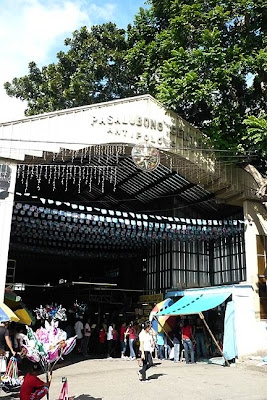
The pasalubong center is already to your left before you get to the gate. Drop by here before you leave the Antipolo Cathedral area.

And finally, the moment of truth. No idea if the church that was completed in 1632 is the same as this one since this structure is all concrete. That first church was destroyed by an uprising by the local Chinese community and the subsequent structures were eventually destroyed by several earthquakes. I will still have to find out the reason for the uprising.

The nave is pretty short for a cathdral - it's just 16 pews long, but the size is compensated by an awesome dome. When I got here, a Requiem Mass was ongoing and there were ten (10) coffins at the altar. Freaky.

Natural light enters from the stained glass windows so the church doesn't require lights during the day. it's very bright and airy.
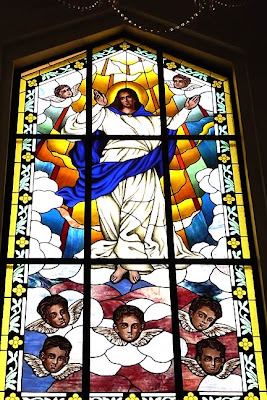
The Assumption of Our Lady into heaven. Each of the cathedral's windows feature a famous title of the Virgin.

Detail. The altar up close. The sun rays of the Holy Ghost mimic that of the Augustinian style, although Franciscans and Jesuits ran this church in its early years.

Detail. The image of our Lady, brought to Manila from Mexico in 1626 and turned over to the Jesuit-run Antipolo church in 1633.

Detail. Christ's Crucifixion on the left side. I didn't ask anyone, but the style is very familiar. Can anyone please confirm if these panels were by Carlos "Botong" Francisco?
THE ANTIPOLO CATHEDRAL (PART DEUX)
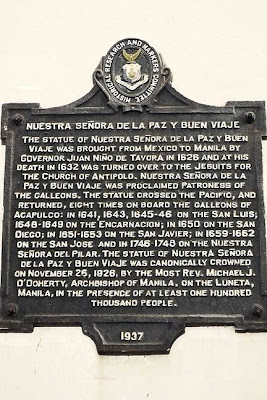
The marker bearing the story of the Marian statue - one of many to cross the Pacific from Mexico. In fact, the image went back and forth many times during the famous Galleon Trade thus the title Buen Viaje (good voyage).
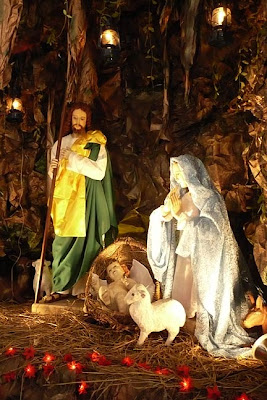
Detail. The nativity display.
THE ANTIPOLO CATHEDRAL (PART TROIS)
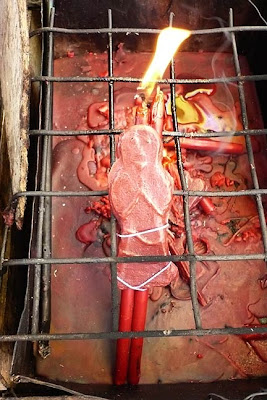
Near the gate, I decided to light a brown candle with two human figures. The girl said this is for thanksgiving. Indeed, how apt - thanksgiving for the graces of 2007 and for those to come this new year.
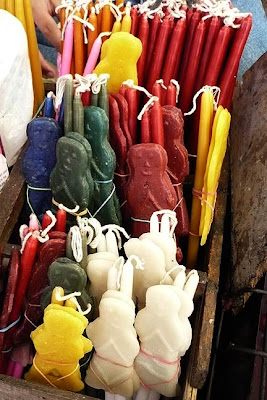
Candles for all occassions. There are candles for all kinds of requests: Brown (thanksgiving), Yellow (health), White ("kahilingan" or request), blue (peace), green (business). The multicolored ones are for the family. Cute.
When in Antipolo, tourists think only of two things to bring back home to loved ones: kasuy (cashew nuts) and suman (rice cakes wrapped in coconut leaves).

This is my all-time favorite. It's been roasted with the skin on so it's nutty and with a slight bitterness to it, too. And it's not oily like what happens to peanuts.
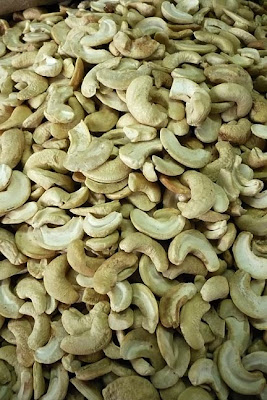
This is my next favorite. It's what they call "plain" because it is not salted. Just simple cashew goodness. This is perfect for summer salads.
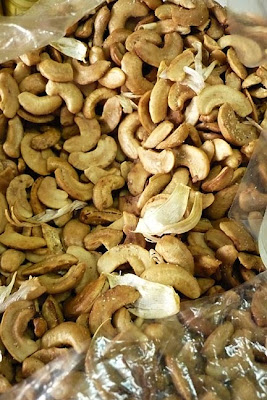
The kasuy goes the adobo route in this new version. It is garlicky and salty. Very tasty because cashew nuts usually do not have a pronounced flavor. During fiesta season (December 8), the tallest glass could cost Php 150 per, but for lean season like now, it's down to Php 50/glass.
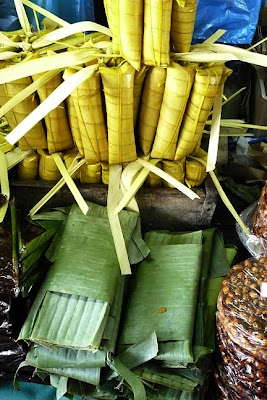
And of course, kakanin! Here we have the famous Antipolo suman and those wrapped in banana leaves are sapin sapin. The latter can be had at Php 100 for 4 packs. Not very mind blowing. Ask first if they are new as old kakanin has that oxidized coconut oil aftertaste.
INTRODUCTION TO THE ESCOLTA SERIES
Everybody who have lived in the City of Manila for years know Escolta like the palm of their hand. Dubbed as the principal business district of Binondo and the whole of Manila for that matter during the 19th century up to about the 1950s, it was said to be comparable in those day-terms with the Ramblas district of Barcelona. Escolta connects two historic districts: Binondo and Sta. Cruz.
I have no idea how the name Escolta came about. Suffice to say that the word escoltar (verbo transitivo; a transitive verb) exists in the Spanish language which means "to escort" and escolta means "body guard". A quick visit to the Images of Asia site reveal that this thoroughfare was initially used by the British Commodore as a convoy route during the years 1762 to 1764.
Looking at Escolta now, I suppose Escolta and the surrounding districts eventually lost their appeal when Cubao in Quezon City and Makati City started to develop. Or so that's what the stories say.
In 2006, former Mayor Lito Atienza signed a memorandum of understanding with the Federation of Filipino-Chinese Chambers of Commerce and Industry, Inc., headed by its President Francis Chua, and the Escolta Commercial Association, Inc., headed by its President Arturo C. Dy, to collaborate efforts to immediately develop and promote Calle Escolta as an ultra-modern IT hub. This is part of the plans to reinvigorate the once prosperous street. An Escolta Waterfront Development Plan was also hatched, part of which is already in place.
Today, Escolta remains to be a busy street thanks to some banks, restaurants, and condominiums that remain to exist here. Notable among the more recent developments is the new Escolta Pasig River ferry terminal which brings to life that area of the street near the bridge.
This is an attempt to record through photographs the continung saga of this famous Manila street. A disclaimer: I am not a historian; therefore, should there be errors in the data presented in the series below, I will be most happy to correct them. Data presented here that may be similar to what is written in other Manila travel blogs is not a coincidence: the data is all over the internet anyway.
Thank you very much and welcome to Manila's Calle de la Escolta.


















